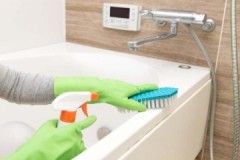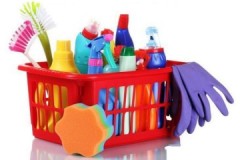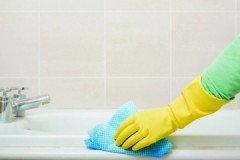Your own plumber, or how to remove the blockage in the bathroom yourself?
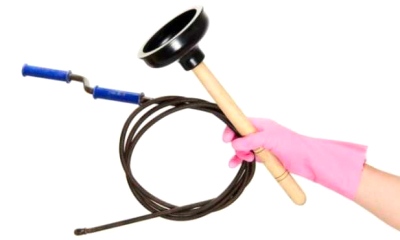 Bathroom blockages are a problem that most often occurs at the most inopportune moment.
Bathroom blockages are a problem that most often occurs at the most inopportune moment.
It is difficult for an untrained person to remove blockages. The process takes a lot of time and does not always end with a solution to the problem.
Having studied in advance all sorts of ways to remove blockages in the bathroom, you can achieve the desired result as quickly and without much effort.
How to eliminate blockage in the bathroom with the help of available tools, chemical compositions and more, we will tell in the article.
Content
The reasons
The main reason for the problem of blockages in the bathroom is lack of regular maintenance of plumbing products... Dirt, grease, hair and other small debris, after each use of the bath, settles on the walls of the drain, the surfaces of the siphon and pipes.
Also, the problem with frequent blockages in the bathroom may be associated with mistakes made during the installation of plumbing products (insufficient pipe diameter, a large number of joints, incorrect slope of the drain pipe).
Depending on what triggered the blockage, one or another method of eliminating the problem is selected.
How to clean using the available means?
Before you run to the store for household chemicals, you need to try to clear the blockage with improvised means.
Baking soda and vinegar
The secret of the effectiveness of this tool is that, entering into a chemical reaction, soda and vinegar form carbon dioxide, which in the narrow space of the sewer pipe pushes the blockage plug.
Algorithm of actions:
- 100 g of soda is poured into the drain hole, after which 100 ml of table vinegar is poured.
- As soon as the chemical reaction begins (determined by the characteristic hissing sound), the drain must be closed with a stopper.
- After an hour and a half, the plug is removed, and at least six liters of hot water are poured into the drain.
Instead of vinegar, you can use the juice of one lemon.
How to clear the blockage with soda and vinegar, the video will tell you:
Boiling water
Boiling water will help dissolve the corks from organic particles (for example, fat). It is enough to open the hot water tap and wait until the hot water dissolves the plug and cleans the drain pipe.
Lemon juice
This method is good when there is slight blockage. drain pipes in the bathroom (water comes off, but very slowly). It is necessary to pour the freshly squeezed juice of three lemons into the drain (about 150 ml). After an hour, the sewer system is flushed with a pressure of hot water.
Edible salt and soda
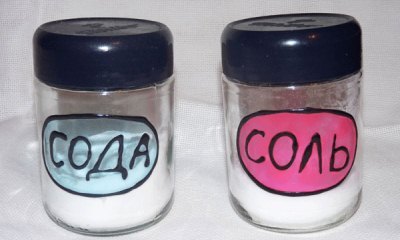 By mixing just two ingredients (200 grams of baking soda needs 500 grams of baking soda), you can get an effective cleaner for drain pipes in the bathroom.
By mixing just two ingredients (200 grams of baking soda needs 500 grams of baking soda), you can get an effective cleaner for drain pipes in the bathroom.
The soda-salt mixture is diluted with water (one liter is enough) and brought to a boil, poured into the drain hole. After two hours, the dissolved cork in the pipes is washed off with water pressure.
The maximum effect can be achieved using only hot cleaning agent. It will not work to remove the cork with the cooled mixture.
Caustic soda
Unlike the usual baking soda, caustic soda is able to clear blockages in the bathroom several times faster. Everything is very simple:
- 200 g of caustic soda are diluted in a liter of warm water;
- the resulting solution is poured into the drain and left for three hours;
- after draining in the bathroom, rinse thoroughly with hot water.
How to remove with a plunger, how to do without it?
The simplest device that is used in the hydraulic cleaning of a blockage in the bathroom is a plunger. Active translational movements of the plunger create the necessary pressure inside the pipe, due to which the plug is destroyed.
Sequencing:
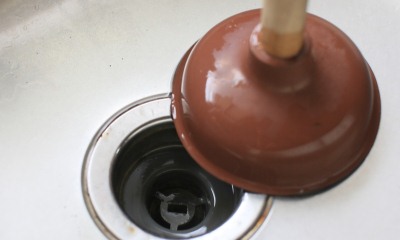 The bath is filled with water (the rubber bowl of the plunger must be completely covered).
The bath is filled with water (the rubber bowl of the plunger must be completely covered).- The rubber bowl of the plunger is firmly pressed against the drain hole.
- Several times, actively pressing the plunger handle, they pump air into the sewer pipes. Under pressure, the plug of the accumulated dirt will begin to collapse.
- A good water pressure will help to finally clean the pipes (for this, the flexible hose of the mixer is inserted directly into the drain hole).
The plunger helps to clean the plugs located as close to the drain hole as possible.
Deep blockages can be cleared by the jetter... The device consists of a compressor and a hose with nozzles. Under strong pressure, water through the nozzle breaks blockages, cleans the inner surface of the drain pipes (brush effect).
During the cleaning process, you only need to control the position of the hose and adjust the water pressure.
A visual process of clearing the blockage with a plunger - in the video:
Mechanical methods
A plumbing cable will help to remove a dense plug in the pipe, which cannot be handled with improvised means. This is a long (up to 10 meters) metal cable (up to 9 mm in diameter) at one end of which a spiral handle is fixed, and at the other - a wire brush or a tip with sharp peaks.
How to work with a plumbing cable:
- The siphon is removed, cleaned of large debris.
- The cable is inserted into the hole of the drain pipe and gently scrolling, push it inside.
- At the moment when the cable rests against the blockage plug, it is slightly pulled towards itself, after which it is pushed again into the depths of the pipe with a little effort. The movements are repeated until the plug is eliminated.
If the water slowly, but still comes off, and there is a persistent smell of sewage in the room, then most likely the cork has formed in the siphon. It can be removed only by dismantling and cleaning this plumbing element.
Algorithm of actions:
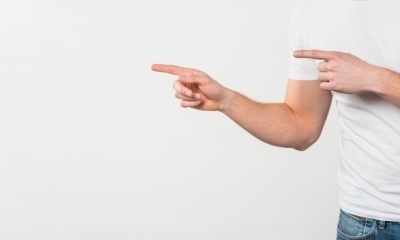 a rag is laid under the siphon and a wide basin is installed;
a rag is laid under the siphon and a wide basin is installed;- carefully unscrew the fastening nut (made of plastic) located at the overflow hole;
- using a screwdriver, unscrew the mounting screw in the drain hole;
- remove the siphon, pour water out of it, unscrew the bottom and clean it of accumulated dirt;
- mount the siphon in its original place;
- tighten the fastener in the drain hole, tighten the plastic nut at the corrugated pipe.
When installing an already cleaned siphon in its original place, it is necessary to ensure that the drain pipe does not rest on the flask. With the correct connection, there should be no sewage smell, water should drain without obstacles.
Chemicals for home use
On the shelves of hardware stores, you can find a variety of bathroom blockages. Choosing the right composition, special attention should be paid to information about what types of pipes it is intended for.
Regardless of the consistency of special means for eliminating blockages in the bathroom (liquid, gel or dry powder), the principle of their action is simple: the mixture is poured or poured into the powder into the drain hole and after a while the pipes are thoroughly rinsed with hot water pressure. The manufacturer indicates the holding time and the amount of the agent used on the label.
TOP-3 of the most effective formulations for eliminating blockages in the bathroom:
Mr. Muscle Pipe Cleaning Powder
Special granules very quickly break down layers of adhered fat, hair and other organic impurities clogging up bathroom pipes. The product is suitable for all types of pipes.
Average price - 100 rubles. (pack 70 gr).
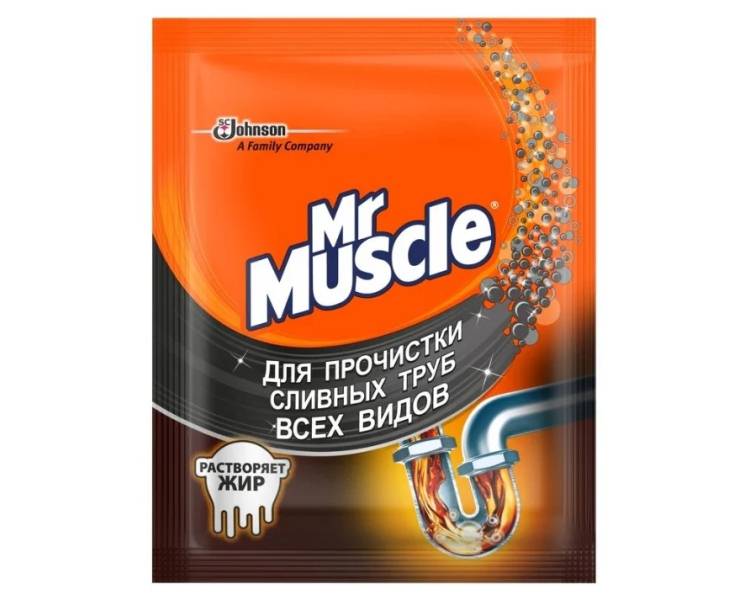
Liquid Mole
Cleans the inner surface of adhered grease, food debris, hair... Eliminates unpleasant odor, kills spores of fungus, mold.
Average cost - 40 rubles. (bottle volume 1 l).
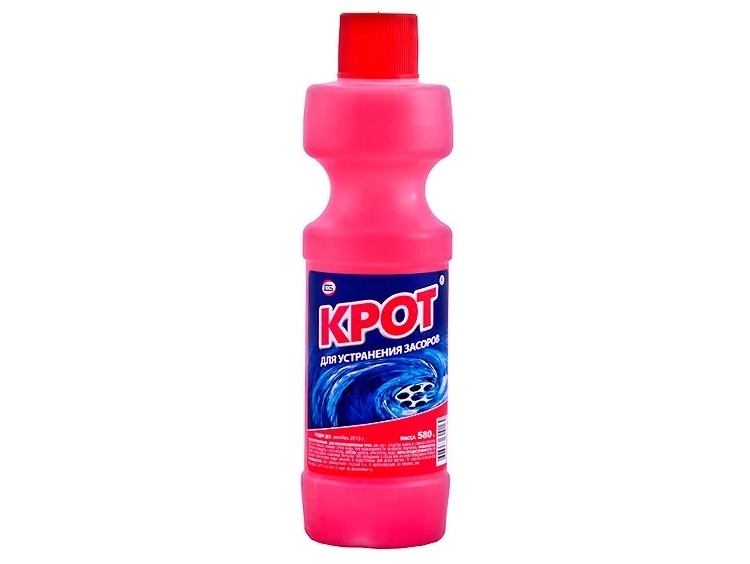
Tiret Gel
Eliminates blockages, disinfects surfaces... The thick gel penetrates deep into the pipe even when there is water in the bathroom. Suitable for all types of pipes.
Average cost - 480 rubles. (bottle volume 1 l).
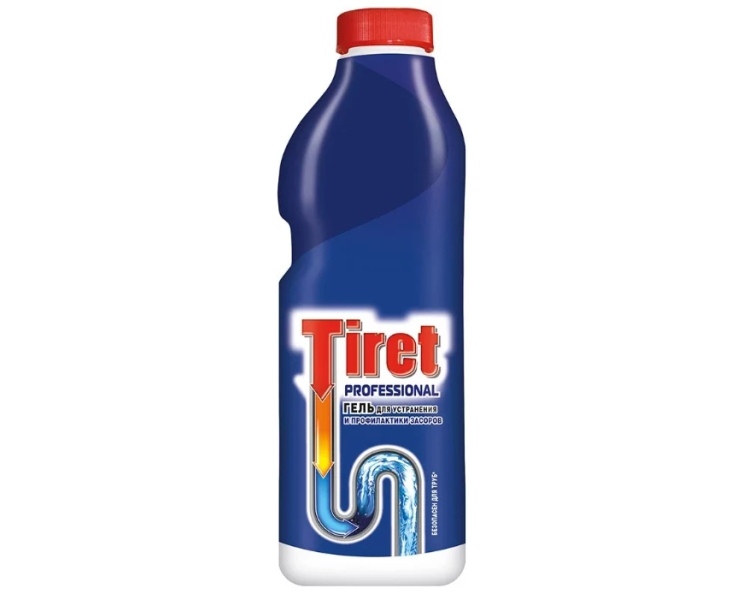
Work on removing blockages from the bathroom using household chemicals can only be carried out in a well-ventilated area with protective gloves and a respirator.
How much does a specialist call cost?
When it was not possible to eliminate the problem of blockages in the bathroom on your own, a professional master comes to the rescue. How to find it?
It is worth asking friends and acquaintances if someone can advise an already proven master... If it was not possible to find a plumbing specialist according to reviews, there are a sufficient number of Internet sites of service centers that provide complete information about the availability of specialists, the types and costs of repair work.
Preventive measures
Prevent bathroom blockages a few recommendations will help:
- after each use of the bathroom, the hair from the drain must be removed;
- preventive cleaning of pipes must be carried out at least once every two weeks;
- a mesh with small cells installed in the bathroom drain prevents small debris from entering the sewer pipes.
Replacing (if possible) all metal pipes with plastic ones will permanently eliminate the problem of rust build-up, corrosion, and frequent clogging of drains.
Advice
Knowing some of the intricacies and secrets of cleaning blockages in the bathroom will help to carry out work quickly and efficiently:
-
 If you don't have a plumbing cable at hand, you can make it yourself. For such purposes, three or four metal wires are twisted together.
If you don't have a plumbing cable at hand, you can make it yourself. For such purposes, three or four metal wires are twisted together.One end of the homemade torso is fluffed up (the ends of the wire are bent in different directions). For convenience, the other end of the homemade cable is tightly wrapped with burlap or any other coarse cloth.
- Alkaline formulations are effective in combating oily plaque, and acid-based products are best used to remove dense blockages from hair, wool, and small debris.
- Processing the rim of the plunger with petroleum jelly will ensure a tighter fit of the rubber bowl to the drain hole of the tub.
All the most important and useful information about bathroom cleaning is collected in this section of the site.
Conclusion
A little patience, neatness and the right method and there will be no trace of blockages in the bathroom.

